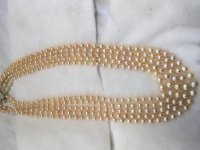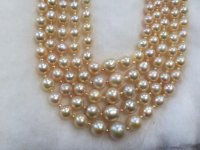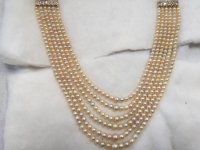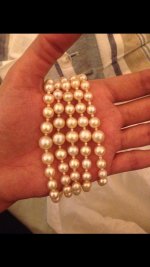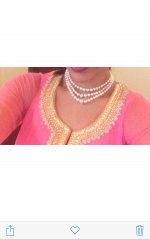You are using an out of date browser. It may not display this or other websites correctly.
You should upgrade or use an alternative browser.
You should upgrade or use an alternative browser.
Reading something online and have a question please
- Thread starter lilliefuzzysocks
- Start date
lisa c
Perpetual Pearl Student
- Joined
- Jun 28, 2009
- Messages
- 3,600
I use my cell phone.
Thank you; aren't they wonderful inventions? I've got a camera that intimidates me, but my cell phone seems more user friendly, thus actually gets used. Plus, it's always available.
Certainly, one isn't expected to change the habits of a lifetime to join PG. I'm sure many people want to clock me frequently for my 'tics' ;-) but they give me plenty of hugs and laughs instead. That's a pretty good deal.
I'm not so sure you're in the right place to avoid envy, however. It's expressed rather frequently and cheerfully around here.
Lagoon Island Pearls
Well-known member
- Joined
- Dec 8, 2009
- Messages
- 2,117
You have beautiful strands. Regal strands, really. Having willingly provided additional photos and supporting certification, you've also indicated to being a collector, not necessarily a salesperson. Whatever their origin, your reverence for pearls is outstanding.
Glancing at the new images, some are consistent (but not exclusive) with pearls from P. radiata, namely luster and color. The shapes are typical of most species.
The sizes are a concern. 5mm to 11mm graduation is not typical. It's rare, especially in multiple strands.
Of the many gulf pearl strands I've seen, most are graduated 2mm to 7mm on average. Market value of single strands in that size range from one to six thousand dollars. Strands more than double that size could fetch four to six times more value. Add multiple strands you'd be looking at six figures without considering the metal, faceted gems and craftsmanship.
I understand in informal settings, such as forums like this, many are reluctant to specify prices paid or offered, but a to discerning collector a "decent price" is a widely subjective term. It can mean dirt cheap or it can mean near to the expected price at auction. Two markedly different things. Appraisal is intended to narrow or eliminate variables, not to confuse or compound them.
Despite my apprehensions, it's fair to suggest lab certification is a reasonable step in determining the origin and value of natural pearls. However, it only adds one or two points supporting authenticity. Anyone would be wise to consider it's limitations. Without impeccable provenance, the value of any questionable object is radically decreased. As in archaeology, without proper documentation and record keeping, the greatest part of any value is lost once it's removed from the site.
From a scientific standpoint drilled pearls are destroyed pearls for the most part.
My only advice would be an abundance of caution and a broadened education. Much of which you'll find from the many talented contributors here.
Glancing at the new images, some are consistent (but not exclusive) with pearls from P. radiata, namely luster and color. The shapes are typical of most species.
The sizes are a concern. 5mm to 11mm graduation is not typical. It's rare, especially in multiple strands.
Of the many gulf pearl strands I've seen, most are graduated 2mm to 7mm on average. Market value of single strands in that size range from one to six thousand dollars. Strands more than double that size could fetch four to six times more value. Add multiple strands you'd be looking at six figures without considering the metal, faceted gems and craftsmanship.
I understand in informal settings, such as forums like this, many are reluctant to specify prices paid or offered, but a to discerning collector a "decent price" is a widely subjective term. It can mean dirt cheap or it can mean near to the expected price at auction. Two markedly different things. Appraisal is intended to narrow or eliminate variables, not to confuse or compound them.
Despite my apprehensions, it's fair to suggest lab certification is a reasonable step in determining the origin and value of natural pearls. However, it only adds one or two points supporting authenticity. Anyone would be wise to consider it's limitations. Without impeccable provenance, the value of any questionable object is radically decreased. As in archaeology, without proper documentation and record keeping, the greatest part of any value is lost once it's removed from the site.
From a scientific standpoint drilled pearls are destroyed pearls for the most part.
My only advice would be an abundance of caution and a broadened education. Much of which you'll find from the many talented contributors here.
Last edited:
lisa c
Perpetual Pearl Student
- Joined
- Jun 28, 2009
- Messages
- 3,600
If harvesting the pearls ourselves is the only way to be sure, then most of us won't end up owning even a single pearl
Pls forgive me for being compelled to be exact again - it'd mean we could own and enjoy as many as we want, we just couldn't call them Natural without provenance of some sort or other. Ach, I'm just going to flip over and enjoy your pictures...
Icyjade
Member
- Joined
- Oct 6, 2014
- Messages
- 573
Icelover, I first need to gush about how much I love your rock star quality rings and other gems. That 8.5 carat diamond ring! Those fancy pink/purplish pink diamond rings! That huge emerald! What a fabulous collection! Please go back to ps and post more of your lovely collection if you can.
Your naturals look so much better than those I see in my local gem fair. So lustrous! Those I've seen look more like misshaped pebbles.
So so so much eye candy... Pls post more of your other pearls too. I'm sure anything else you have must be fantastic and eye opening.
Your naturals look so much better than those I see in my local gem fair. So lustrous! Those I've seen look more like misshaped pebbles.
So so so much eye candy... Pls post more of your other pearls too. I'm sure anything else you have must be fantastic and eye opening.
I'm not so sure you're in the right place to avoid envy, however. It's expressed rather frequently and cheerfully around here.
You are right. I have a lot of bling envy going on from time to time on forums like these
BAS
Well-known member
- Joined
- May 25, 2013
- Messages
- 1,944
icelover -- thank you so much for posting more pictures.
I would love to see pictures of all your clasps up close. Are you willing/able to do that?
You said you have dozens of pictures. Well, I'd love to see them all! I've never seen a collection like yours and would enjoy every picture you are willing to post.
I'm so glad you found us and joined. Welcome!!!
I would love to see pictures of all your clasps up close. Are you willing/able to do that?
You said you have dozens of pictures. Well, I'd love to see them all! I've never seen a collection like yours and would enjoy every picture you are willing to post.
I'm so glad you found us and joined. Welcome!!!
You have beautiful strands. Regal strands, really. Having willingly provided additional photos and supporting certification, you've also indicated to being a collector, not necessarily a salesperson. Whatever their origin, your reverence for pearls is outstanding.
Glancing at the new images, some are consistent (but not exclusive) with pearls from P. radiata, namely luster and color. The shapes are typical of most species.
The sizes are a concern. 5mm to 11mm graduation is not typical. It's rare, especially in multiple strands.
Of the many gulf pearl strands I've seen, most are graduated 2mm to 7mm on average. Market value of single strands in that size range from one to six thousand dollars. Strands more than double that size could fetch four to six times more value. Add multiple strands you'd be looking at six figures without considering the metal, faceted gems and craftsmanship.
I understand in informal settings, such as forums like this, many are reluctant to specify prices paid or offered, but a to discerning collector a "decent price" is a widely subjective term. It can mean dirt cheap or it can mean near to the expected price at auction. Two markedly different things. Appraisal is intended to narrow or eliminate variables, not to confuse or compound them.
Despite my apprehensions, it's fair to suggest lab certification is a reasonable step in determining the origin and value of natural pearls. However, it only adds one or two points supporting authenticity. Anyone would be wise to consider it's limitations. Without impeccable provenance, the value of any questionable object is radically decreased. As in archaeology, without proper documentation and record keeping, the greatest part of any value is lost once it's removed from the site.
From a scientific standpoint drilled pearls are destroyed pearls for the most part.
My only advice would be an abundance of caution and a broadened education. Much of which you'll find from the many talented contributors here.
Agree with most of what you say. I am hesitant to talk about what I paid for these but it definitely a fortune. I don't know about pearl market in other countries but as of last 7-10 years pearl prices have been consistently going up and you can make a nice profit if you sit on them patiently for a few years (I know a few friends who bought and sold)
I don't have deep knowledge about natural pearls but have a few jewellers I get my pieces appraised from before I buy. I just love looking at them and love the fact that I'm fortunate enough to own some. As long as I have the confidence that I can always sell and make at least a small profit- that's good enough ( again I have helped this happen with a few friends) where I live,jewellery business is more in terms of trust and neither me nor my family got cheated so far. We still try to be careful by taking several opinions from experts. And from what I gave noticed, the jewellers are especially careful with people who can afford expensive things and who has connections since they have the means to effect that particular jewellers reputation and important customers. The jewellery stores that sell these pearls have been in business for at least 80-90 years and they are unblemished so far...so I would like to think I am being as careful as I can
Pearl Dreams
Pearl Enthusiast
- Joined
- Sep 24, 2007
- Messages
- 9,881
I've enjoyed looking at your rubies on Pricescope!
http://www.pricescope.com/forum/col...5-carat-untreated-burmese-rubies-t187632.html
http://www.pricescope.com/forum/colored-stones/more-burmese-t204507.html
http://www.pricescope.com/forum/col...5-carat-untreated-burmese-rubies-t187632.html
http://www.pricescope.com/forum/colored-stones/more-burmese-t204507.html
pattye
Pearl Scholar
- Joined
- Dec 26, 2005
- Messages
- 11,540
Icelover,
Thank you soooo much for posting all the photos of your amazing pearls, and so openly sharing the background infomation. You are absolutely gorgeous in them.
The construction and knotting or lack of it is fascinating to me. Do you know if they are strung on silk? Would also love to see the clasps. And coordinating earrings? The photos we usually see of naturals this size are photos from Sotheby's or Bonham's auctions, and aren't close enough to see the details and shapes. (Although our member, Anna, aka Cliclasp, has provided us with fabulous photos from museum collections.)
Returning to look at the photos again!
Thank you soooo much for posting all the photos of your amazing pearls, and so openly sharing the background infomation. You are absolutely gorgeous in them.
The construction and knotting or lack of it is fascinating to me. Do you know if they are strung on silk? Would also love to see the clasps. And coordinating earrings? The photos we usually see of naturals this size are photos from Sotheby's or Bonham's auctions, and aren't close enough to see the details and shapes. (Although our member, Anna, aka Cliclasp, has provided us with fabulous photos from museum collections.)
Returning to look at the photos again!
Last edited:
CathyKeshi
Well-known member
- Joined
- Mar 16, 2014
- Messages
- 4,706
Icelover, thanks so much for posting photos ... no, we're NOT at all bored; please post more  !!!
!!!
Thanks everybody for all the love. Yes I have some pairs of earrings. Posing some old pictures I have
1) the long dangly earrings have 10mm pearls each.
2) the studs are 10.5mm each
3) the danglies with two diamonds are 11.5mm each
4) and finally the dang lies with baroque/weird pear are 16-16.5mm in length.
Attaching a few picture before setting also. All are certified from the Mumbai lab.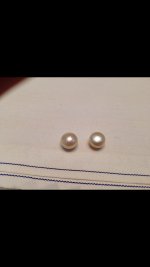
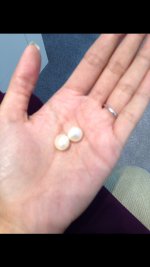
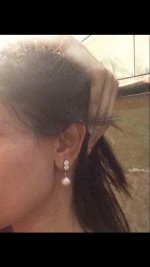
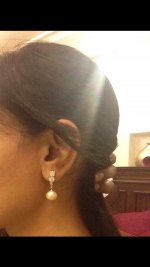
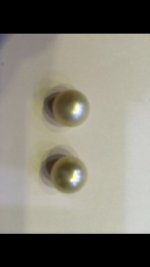
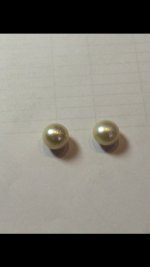
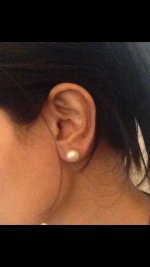
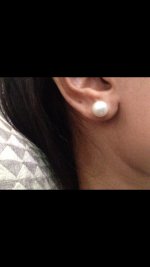


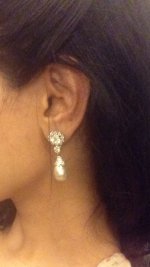
1) the long dangly earrings have 10mm pearls each.
2) the studs are 10.5mm each
3) the danglies with two diamonds are 11.5mm each
4) and finally the dang lies with baroque/weird pear are 16-16.5mm in length.
Attaching a few picture before setting also. All are certified from the Mumbai lab.











CathyKeshi
Well-known member
- Joined
- Mar 16, 2014
- Messages
- 4,706
WOW! All stunning; my personal favorites are the last pair; dangly "weird" pearls ... LOVE those  Thanks again for sharing!
Thanks again for sharing!
Caitlin
Well-known member
- Joined
- Dec 11, 2004
- Messages
- 8,502
Icelover! Let me add my thanks for sharing your photos!! Each photo is an education in what naturals can look like.
I know that the old pearl-selling families selling these pearls never did have labs, they just had their reputations. In India, any given pearl can be hundreds of years old. Round pearls are highly prized and have been for thousands of years. India has always had a voracious appetite for pearls and has gobbled up most of the production from the Persian Gulf for millennia. The rest of the world -like European royalty -got most of their pearls from the New World while the "pearl rush" was on, or from intrepid travelers like Tavernier who managed to get some local rajas to sell him some really fancy pearls which he then sold in Europe.
I think logically speaking, most of the round pearls in the world are already in India, and the round ones not already there are going to end up there. And, India may be the only place in the world where real pearls are worth as much or more on resale.
IceLover, I feel as though we now have a kind of informant who can share her pearls from an Indian POV. Like, when do you wear one of those multistranded sets? A wedding? To the theater? They are really formal. Do you have any fun strands you can wear?
I also have a question. What family do the sellers you trust come from? A name I have seen crop up outside of India, in the Persian Gulf, and other areas of the world such as Monterrey Mexico is some variation on the name Javari. The spelling varies, Jharvari, Javerri, and at least one other variation I can't recall at the moment. They may sell other gems as well, but wherever they are in the world, they seem to have natural pearls. Have you heard the name in connection with pearls? Does that name Javari have a meaning?Is it based on a word?
I know I am asking a lot, but India is "da bomb" when it comes to pearls! Do you have any folklore or historical knowledge about pearls in India? Are there any pearl scholars, so to speak in India? Are there articles on the ancient pearls and pearl beds of India anywhere? At the moment, pearls in India is a subject we westerners know virtually nothing about, yet India is the biggest nation of pearl lovers in the world.
I know that the old pearl-selling families selling these pearls never did have labs, they just had their reputations. In India, any given pearl can be hundreds of years old. Round pearls are highly prized and have been for thousands of years. India has always had a voracious appetite for pearls and has gobbled up most of the production from the Persian Gulf for millennia. The rest of the world -like European royalty -got most of their pearls from the New World while the "pearl rush" was on, or from intrepid travelers like Tavernier who managed to get some local rajas to sell him some really fancy pearls which he then sold in Europe.
I think logically speaking, most of the round pearls in the world are already in India, and the round ones not already there are going to end up there. And, India may be the only place in the world where real pearls are worth as much or more on resale.
IceLover, I feel as though we now have a kind of informant who can share her pearls from an Indian POV. Like, when do you wear one of those multistranded sets? A wedding? To the theater? They are really formal. Do you have any fun strands you can wear?
I also have a question. What family do the sellers you trust come from? A name I have seen crop up outside of India, in the Persian Gulf, and other areas of the world such as Monterrey Mexico is some variation on the name Javari. The spelling varies, Jharvari, Javerri, and at least one other variation I can't recall at the moment. They may sell other gems as well, but wherever they are in the world, they seem to have natural pearls. Have you heard the name in connection with pearls? Does that name Javari have a meaning?Is it based on a word?
I know I am asking a lot, but India is "da bomb" when it comes to pearls! Do you have any folklore or historical knowledge about pearls in India? Are there any pearl scholars, so to speak in India? Are there articles on the ancient pearls and pearl beds of India anywhere? At the moment, pearls in India is a subject we westerners know virtually nothing about, yet India is the biggest nation of pearl lovers in the world.
Similar threads
- Sticky
- Replies
- 12
- Views
- 1K

